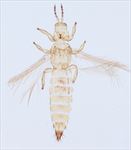Distinguishing features
Female macroptera. Body brown to dark brown, much paler when teneral with shadings around the eyes and abdomen variably brown but with at least tergite X dark; antennal segment I as brown as head, II darker, III light brown, IV–VIII brown; fore wings deeply shaded with base paler. Antennae 8-segmented, III–IV with forked sense cone. Head wider than long; vertex, excluding ocellar triangle, with sculpture lines; 3 pairs of ocellar setae, pair III slightly longer than longitudinal diameter of an ocellus, arising between posterior margins of hind ocelli; 4 pairs of small postocular setae. Pronotum with weak lines of sculpture, 2 pairs of rather short posteroangular setae; median posteromarginal setae no longer than remaining 3 pairs of posteromarginals. Mesonotal anterior campaniform sensilla present. Metanotum with irregular reticulation posteromedially; campaniform sensilla present; median setae at anterior margin. Mesofurca with spinula. Fore wing first and second veins with complete row of setae; clavus with 5 veinal and one discal setae. Tergites without craspeda; V–VII without ctenidia but with microtrichia on lines of sculpture laterally; sculpture lines extend to median setae; VIII with paired ctenidia anterolateral to spiracle, posteromarginal comb of regular microtrichia. Sternites without discal setae; VII with setae S1 arising at margin.
Male macroptera. Similar to female but smaller, colour similarly variable from brown to yellow; antennal segments I–II yellow or dark brown, III–VIII brown; tergite VIII comb long and regular, median pair of setae on IX well-developed; sternites III–VII with small circular pore plate; sternite VIII posterior margin with long slender microtrichia.
Related species
Species of the genus Pseudanaphothrips share many character states with species of Frankliniella, but none of them have tergal ctenidia so well-formed. Currently the genus includes nine species, all but one from Australia. However, some of these are based on very few specimens, and these remain particularly difficult to distinguish (Mound & Palmer, 1981). P. casuarinae is interpreted here as a variable species. The type specimens, and others collected from Allocasuarina paludosa in southern Australia, are brown to dark brown, but specimens studied from Casuarina equisetifolia in Southeast Queensland are much paler. These are here interpreted as teneral. The females have the pronotal median postermarginal setae small, and the comb on tergite VIII regular, but the pale males are similar to those of P. aureolus.
Biological data
Feeding and breeding within the male cones of Allocasuarina paludosa and Casuarina spp [Casuarinaceae].
Distribution data
Recorded only from southeastern Australia (South Australia, Australian Capital Territory, New South Wales, Tasmania, Queensland).
Family name
THRIPIDAE - THRIPINAE
Species name
Pseudanaphothrips casuarinae Mound & Palmer
Original name and synonyms
Pseudanaphothrips casuarinae Mound & Palmer, 1990: 3.
References
Mound LA (2002) The Thrips and Frankliniella genus groups: the phylogenetic significance of ctenidia. Pp. 379–386 in Marullo R & Mound LA [eds] Thrips and Tospoviruses: Proceedings of the 7th International Symposium on Thysanoptera. Australian National Insect Collection, Canberra.




